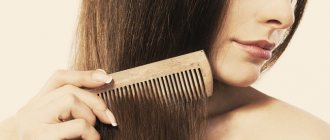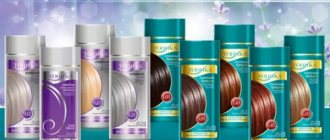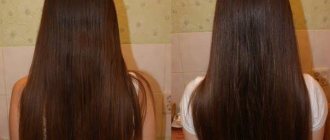Causes of pseudofolliculitis and why it is dangerous
Occurs in cases:
- With each depilation, the hairs become thinner, weaker, lighter, and cannot break through the surface layer of the epidermis.
- The hair removal technique is performed incorrectly.
- A woman does not perform the necessary proper body care after depilation (scrubbing, cleaning with a hard washcloth, moisturizing).
- Constantly wearing narrow, tight clothing, the friction of which against the body leads to rapid keratinization of the upper skin layer and clogging of pores.
In rare cases, the problem is caused by a hormonal imbalance that affects the activity of hair growth or hyperkeratosis (pathologically rapid keratinization of the epithelium). Papules may appear when the immune system is weakened.
The threat is that a serious inflammatory process and suppuration occurs. Pseudofolliculitis may be accompanied by itching, pain, and increased body temperature in the area of depilation.
If you open the ulcers yourself, comb the wounds without maintaining sterility, it is possible that a secondary infection will occur, which will lead to serious consequences.
Why do they appear?
There can be many reasons for the appearance of improperly growing hairs.
- Professionals say that this is due to the thick layer of the epidermis. The thicker the layer of epidermis, the more difficult it is for a newly growing hair to break through the skin. Thus, after depilation it grows in a horizontal direction, which is not normal.
- In addition, the reason may be hidden in changes in hormonal levels or damage to hairs when shaving. If you shave against your height, you also run the risk of developing this problem.
- In the bikini area, problems appear if you often wear synthetic underwear that is too tight and uncomfortable. You can avoid ingrown hairs in the bikini area by wearing cotton underwear that fits properly.
What type of hair removal causes the problem?
Pseudofolliculitis after depilation also depends on the technique itself.
It occurs less frequently after shaving with a razor. Much more often, such a misfortune is observed after an epilator, as well as after removing unwanted vegetation using waxing techniques, less often sugaring.
Pseudofolliculitis is provoked mainly by methods in which hairs are pulled out by the roots. This thins them, makes them weaker and more fragile, unable to break through the epithelium, which manages to overgrow while the follicle grows a new hair.
Professional fight against unwanted and ingrown hair
If hair removal using the wax or sugar method was carried out in a salon by a specialist, this does not guarantee the absence of unpleasant consequences. Although there may be significantly fewer of them, provided that the cosmetologist has a good command of the technique.
Girls often make mistakes on their own, which leads to problems.
In professional settings, laser and electrolysis are used. With hardware techniques, the hair follicle is completely destroyed and it no longer grows from it.
What types of ingrown hairs are there?
There are several different types of ingrown hairs based on the direction they grow and their appearance.
- Superficial ingrowth: The hair runs parallel and directly under the skin. This phenomenon is somewhat similar to a sliver.
- Ingrown hair sticking: Hair grows out of the follicle and returns back to the follicle in another location. Visually, it also looks like a superficial ingrown hair.
- Spiral ingrowth: hair fails to grow out of the follicle and returns back into it. At the same time, they continue to grow around the follicle.
- Ingrowth in transit: The hair fails to grow out of the follicle and moves under the skin. In this case, the hair finds its way out in another place.
Fighting ingrown hairs in a medical facility
Sometimes the best way to deal with ingrown hair on your legs, bikini area or any other area is to seek professional help from a clinic, namely a dermatologist. A visit to a doctor is recommended when the affected area is large or there is a strong inflammatory process in the layers of the dermis. Independent actions in such cases are undesirable - the risk of infection is high.
Removal in a medical office:
- The body area is treated with an antiseptic.
- If necessary, local anesthesia is applied to the epidermis.
- The doctor opens the papules and ulcers with a scalpel or needle.
- The wounds are washed with an antiseptic solution and sometimes cauterized.
- For healing, an antibacterial drug is applied to the surface of the skin and a sterile bandage is applied.
The consequences of surgical opening of inflamed papules are favorable, provided the patient observes hygiene standards.
Drugs used to treat pseudofolliculitis
You can cope with inflammation after depilation with the help of medications, cosmetics and other aids.
Cream Vaniqa
This is a very effective cream for combating ingrown hairs, which can be applied to absolutely all epilated areas of the body. Use immediately after hair removal and depilation, with regularity every 3-4 days.
"Follivit" cream
Helps avoid the problem by slowing down the rate of growth of the hair shaft and promoting the correct direction. Relieves inflammation and redness.
Gel Gloria
Gloria anti-ingrown hair gel is suitable for all areas. With its regular use, the problem disappears completely. Gloria has many positive reviews and has established herself among the girls.
Lotion Skin doctors
Eliminates negative consequences after shaving with a blade and depilation. Acts as a preventative against pseudofolliculitis on the legs, chin and neck, under the arms in the pubic area, quickly relieves symptoms of irritation.
Lotion Ingrow
An effective remedy. Also used after shaving and hair removal. Recommended for women and men.
Ichthyol ointment
Ichthyol ointment - helps well against inflammation and prevents the problem of ingrown hairs after hair removal. When papules appear, the product is applied to them pointwise, covered with cling film and left overnight. In the morning, the skin is scrubbed and treated with an antiseptic.
Ichthyol ointment can be used for all areas of the body.
Levomekol ointment
Levomekol kills germs, relieves inflammation and redness. Used in the same way as Ichthyol ointment. These drugs are similar in action.
Folk remedies
Traditional recipes for solving the problem of ingrown hairs after hair removal are based on natural ingredients and are as safe as possible.
Salicylic-honey peeling
Ingrown hair on the legs and other parts of the body can be dealt with using salicylic acid. It is not advisable to use this method for the bikini area.
You need to make the following mixture: mix 30 ml of salicylic acid with 2 tsp. honey Apply the mixture to the body area and leave for 15 minutes. Afterwards, rinse and scrub the skin. The product exfoliates the dead layer of the epidermis and helps get rid of papules, freeing hairs.
Salicylic acid is used no earlier than 7–10 days after hair removal.
(2016)
Salt scrub
Coarse sea salt can be used as a preventive measure. This scrub also helps get rid of blemishes and flaking.
2 tsp. salts are mixed with 2 tbsp. l. any cosmetic oil and thoroughly scrub the body with this mass. The skin becomes soft, the stratum corneum peels off and the hairs come out. This scrub can be used on the arms, legs, under the arms and in the bikini area.
Bodyaga
Ingrown hairs after sugaring or waxing can be removed using a natural remedy - bodyagi. The powder is mixed with 3% hydrogen peroxide 1:1, and the mixture is applied to the affected area. The mask is left for 15–20 minutes, then washed off. Badyaga helps well against ingrown spots, blackheads on the legs, and bumps. This product should not be used on very sensitive skin.
Lemon
The juice of 1 lemon is mixed with 3 tbsp. l. glycerin and rub the liquid into the skin. After 15 minutes, wash off and scrub the area. Citric acid can be replaced with apple cider vinegar. This mixture helps not only fight ingrown hair on the legs, but also avoid the appearance of marks and spots.
To remove stains from ingrown hairs that are already present, you need to wipe the area with a slice of lemon every day.
Essential oils
Essential oil is an effective remedy against irritation and changes in the growth of the hair shaft. Suitable oils: lemon, sage, rosemary, fir, eucalyptus, mint, lemon balm, ylang-ylang, tea tree. The ether is mixed with any base cosmetic oil in a ratio of 1:8 and the mixture is rubbed into the skin. Essential oils fight ingrown hairs, have a healing and anti-inflammatory effect, remove itching, redness, and age spots.
Natural home remedies for ingrown hairs!
1) Ice
To reduce inflammation of ingrown hairs, apply ice or a cold compress to the affected area. Cold is especially helpful when you experience pain or itching. These are common symptoms that accompany ingrown hairs.
2) Tea tree oil
This essential oil from the Melaleuca alternifolia plant is known for its ability to improve skin health. Its antimicrobial activity is broad spectrum. That is, tea tree oil helps with bacterial, viral, fungal and protozoal infections that affect the skin. In addition, it perfectly accelerates the healing of wounds.
This is the reason why tea tree oil is effective against ingrown hairs. It is an excellent natural antibacterial agent. Thanks to its antiseptic and antibiotic properties, it helps with many skin diseases.
Simply apply one or two drops of pure oil to ingrown hairs once a day. This will prevent infection and inflammation. And thereby you will significantly speed up the healing of the skin.
Note!
Remember that tea tree oil is quite strong in its effects. You need to take just a little bit of it. 1 – 2 drops is enough. Apply them to a cotton swab and then to irritated skin.
If you are using it for the first time, it is better to test for an allergic reaction. Simply apply a little oil to a small, inconspicuous area of skin. If after 24 hours you do not have any rash or other symptoms, you can use it.
Of course, even then, 100% pure oil may dry out your skin a little. Then try to simply moisturize it with coconut or almond oil. If desired, use your regular moisturizer.
3) Baking soda
What product does everyone have in their kitchen? Well, of course, baking soda. This is something that everyone has on hand. But most importantly, it is quite mild in its action. This means that it is suitable for people with sensitive skin.
And even ingrown hairs can be corrected with soda paste. First of all, it prevents the follicle from becoming clogged until the hair grows back properly. In addition, it reduces existing inflammation.
To make a paste, simply mix enough baking soda with water. The result should be a paste. But it should not be too liquid to stick to the skin.
Also, don't apply it too thickly. After all, it will quickly fall off. The baking soda paste should just stick well to the skin.
Be sure to wash your hands thoroughly with soap and warm water before applying the paste. Apply the paste using gentle circular movements with your fingers, as if massaging it into the skin.
Leave it on for a few minutes for it to take effect. Just follow your feelings. If you have small open wounds, it may sting a little. Nothing wrong with that. But if the sensations become unbearable, immediately wash off the paste with cold water. At the end of the procedure, be sure to apply a small amount of coconut oil to the area to moisturize.
4) Lemon juice
At first glance, it may seem that lemon juice is a rather aggressive method. But he certainly won’t be able to make the problem worse.
In fact, lemon juice is an ordinary natural acid. And it works great to stop bacteria from colonizing ingrown hair follicles. In addition, the high content of vitamin C also promotes healthy skin.
In general, simply applying lemon juice to ingrown hairs will prevent infection and reduce redness.
5) Apple cider vinegar
Here's another universal remedy for you. Be sure to try apple cider vinegar. This is a real all-natural thing that will help ease discomfort. Not only that, apple cider vinegar prevents new ingrown hairs from appearing.
Of course, some people may have an allergic reaction to apple cider vinegar. Therefore, start treatment slowly. If you do not have negative reactions, you can increase the number of procedures.
Over time, you will find that it is the best medicine with powerful anti-inflammatory properties.
Soak a cotton ball in apple cider vinegar and apply to the affected areas. When it is completely dry, you can rinse your skin with water.
Repeat the procedure several times a day until the burning sensation disappears and the bumps are no longer visible.
6) Strawberry
Among all the tips, we have delicious recipes too! But this point is more suitable when there are already glowing red bumps at the site of ingrown hairs.
So let's make strawberry paste. Mash the strawberries with sour cream to form a relatively thick paste. Apply it to ingrown hairs and leave for 20 minutes. Then rinse off with cool water.
Strawberries contain fruit acids that are very similar in action to citric acid.
7) Coconut oil
But this product brings only one pleasure! Many oils are commonly used for cooking. But some of them are also excellent cosmetics. That is, they can be used similarly for lubrication during shaving.
They not only moisturize, but also allow the razor to glide easily over the skin. This ensures a smoother shave without skin irritation.
Coconut oil, in particular, can be used on its own as a separate product. It can work real miracles when it comes to eliminating those pesky ingrown hairs.
This incredible gift of nature offers many benefits. For example, I would like to note the accelerated healing of the skin. And all this thanks to the high content of lauric acid.
In addition, coconut oil has antiseptic properties. And this is incredibly useful for eliminating cuts, burns and skin rashes. That is, everything that accompanies ingrown hairs. But at the same time, the skin remains completely hydrated.
And using coconut oil is generally easier than ever. Simply apply a thin layer of oil to your skin. Then you can shave in peace.
 Epsom salt
Epsom salt
Do you have irritated skin after shaving? Then this is the tool for you. Run a bath with warm water and add two cups of Epsom salts.
Soak in the Epsom salt bath for at least 10 minutes, but no more than 30 minutes. Then apply moisturizer.
If you do not have the opportunity to take a bath, we can offer an easier, but no less effective method. Dissolve 2 tablespoons of Epsom salt in a cup of water. Soak a cotton swab in it and leave it on the affected area for 10 minutes.
This method will help exfoliate dead skin cells and remove ingrown hairs.
9) Coffee
Lately, coffee has become much healthier than it used to be. In what recipes can you not find it? Well, we couldn’t ignore it either.
The acidic properties of your favorite morning drink make it easy to free ingrown hairs. Simply mix a cup of warm water with about a quarter cup of unused coffee. That is, you should get something like a paste.
Massage the coffee paste onto the affected areas, working it in circular motions for a few minutes. After this, rinse with cool water and then moisturize. Ideally, aloe vera gel or coconut oil.
10) Sugar
Again, another universal product that everyone has in their home. But you just have to eat it! We will be preparing an excellent skin scrub that can easily remove ingrown hairs.
It gently exfoliates the skin, removing dead skin cells and stimulating hair release from the skin. But it also offers another benefit. After using it, your skin will be smooth and silky.
To make this sugar scrub, you only need one cup of white sugar. To it you need to add half a cup of jojoba oil or extra virgin olive oil. If desired, add another 10 drops of lavender and tea tree essential oils. Mix everything well.
Apply a small amount of sugar scrub to the affected areas. Then gently massage it into your skin using circular motions. Continue to do this for several minutes. Finally, rinse with cool water.
Leftovers of this scrub can be stored in an airtight container for later use. Repeat the procedure once or twice a week as needed.
11) Aspirin
Aspirin is known to help reduce inflammation and redness. These are the two most common symptoms seen with ingrown hairs.
In fact, aspirin contains anti-inflammatory compounds that help reduce swelling, inflammation, and mild infection. In addition, it consists of salicylic acid. And it is known to be excellent at removing dead skin cells, thereby weakening ingrown hairs.
So, all you need to do is soak 2 aspirin tablets in a teaspoon of warm water. You will get a light paste-like consistency. Add a teaspoon of honey to the mixture and then apply it to the affected areas.
Leave the paste on for 10 minutes and then rinse off with cool water. Use this remedy once or twice a week, as needed.
12) Black tea bags
Surely, you will definitely have black tea! And this is one of the simplest remedies for ingrown hairs.
But why? Yes, black tea simply contains tannic acid. It is known to relieve inflammation, reduce redness and relieve burning sensation.
Just soak a black tea bag in water, but not too hot. Rub it over the affected areas for a few minutes. Repeat the procedure several times during the day.
13) Aloe vera
Aloe vera is another famous medicine that has been used for centuries to relieve all types of ailments. For example, in traditional Indian medicine they treated constipation, worm infections, infections, and colic. However, skin diseases responded better to this treatment: burns, herpes, eczema.
Likewise, you can use it to reduce inflammation. Simply break off a piece of aloe leaf and squeeze the gel inside directly onto the affected area.
If you don't have an aloe vera plant, you can purchase ready-made aloe vera gel. But just make sure there are no chemicals, flavors or artificial colors in it.
14) Calendula oil
Many oils can work real miracles on the skin, including calendula oil. It is extracted from calendula flowers and is renowned for its powerful antiseptic and soothing properties.
First of all, it helps soothe burning, irritated skin, reducing redness and relieving pain. Before applying to affected areas, dilute about six drops of the oil with a teaspoon of jojoba, almond or coconut oil. Otherwise, the irritation may only get worse.
15) Witch hazel oil
This is a famous oil that can deal with nasty acne. But not many people know that it also perfectly removes irritation and inflamed ingrown hairs.
Primarily, it acts as a natural antiseptic to reduce inflammation. In addition, it also contains tannins, which reduce swelling and kill bacteria.
You just need to soak a cotton swab in the oil and apply it to the inflamed blisters of ingrown hair. This oil will significantly speed up healing and reduce irritation and redness.
16) Lavender essential oil
In fact, it is one of the most versatile essential oils on Earth. So if you don't have one yet, be sure to buy it! It helps with stress, anxiety and insomnia. This is a real indispensable assistant for bee stings, motion sickness, cuts and minor burns. And, naturally, it will help when ingrown hairs are already inflamed.
Keep in mind that it has anti-inflammatory, antiseptic, antibacterial, astringent, cleansing and moisturizing properties. This means you definitely need to try it.
And using it is generally easier than ever. Just rub a couple of drops on your palms and apply to desired areas of the body.
17) Frankincense essential oil
Frankincense is another great essential oil to have on hand. Its main benefits are relieving chronic stress and anxiety, reducing pain and inflammation.
Moreover, it has antiseptic and disinfectant properties. That is why it can be used instead of chemical household cleaners.
Additionally, its soothing properties help heal inflamed skin. But antiseptic compounds kill germs, which further aggravate the situation of ingrown hairs. It can be applied pointwise to the affected areas.
18) Sugar and salt
Will waxing help prevent ingrown hairs? In fact, waxing, on the contrary, promotes the appearance of ingrown hairs. But no one is stopping you from considering an easier and safer form of this hair removal technique.
As an alternative to harsh chemical waxes, try a homemade sugar scrub recipe.
Sugaring usually uses a paste made from a combination of sugar, honey, water and lemon juice. It removes hair perfectly without damaging the skin at all. So this option is especially good for people with sensitive skin.
Sugar and salt are considered natural, gentle exfoliants. They not only can, but even should be applied to ingrown hairs to reduce redness or irritation.
Therefore, we would like to recommend you a homemade body scrub with sugar and sea salt. This is a great combination of these two famous great scrubs.
To prepare it you will need:
- 1/2 cup coarse sugar or date sugar;
- 1/4 cup sea salt;
- 2 tablespoons honey;
- 1 teaspoon jojoba oil;
- 1/8 cup shea butter;
- 2 tablespoons coconut oil;
- 5 - 10 drops of pure peppermint essential oil.
Place sugar, sea salt in a bowl and mix everything well with a spoon.
Then add coconut oil, honey and shea butter. Mix well again. Only then add jojoba and peppermint oil.
Next, transfer the mixture into a small glass jar with a lid. It can be stored in the refrigerator and used as needed.
While in the shower, simply apply a small amount with your fingertips to the desired body parts. Massage lightly in circular motions for about 10 - 15 seconds. Finally, rinse the skin, dry with a towel or air dry.
This product perfectly removes ingrown hairs and prevents their further appearance.
19) Tonic
We often use this product for face and skin care. But we almost never think that it is suitable for other areas. So if you have such a product at home, you can use it too.
But just apply it at least once a day by soaking a cotton pad or cotton swab in the toner. It would be great if the toner contained salicylic acid. After all, it helps soothe inflamed ingrown hairs.
Advice!
If you've recently had a bikini wax, be sure to wait at least a day or two before applying the toner to your skin. Your skin may still be extremely sensitive. So let it heal a little first.
Prevention
- Compliance with hair removal technique is the most important factor. When using a blade, the hairs are shaved according to their growth; when waxing, they are removed against growth.
- If hair grows in after epilation, despite all the precautions taken, it is worth changing the technique and observing the result.
- After the procedure, you must follow all skin care rules.
- To get rid of pseudofolliculitis after epilator, sugaring, waxing, cosmetics that slow down hair growth, which are widely sold, will help.
- If a lump appears, it is better to open it.
- When hair grows on your legs, it is not recommended to wear tight pants often.
- Regular use of scrubs is an effective way to help get rid of blackheads and ingrown follicles.
The danger of ingrown hairs
Ingrown hairs after sugaring significantly spoil the attractiveness of the skin. They bring considerable complications:
- Redness appears.
- The affected area becomes inflamed.
- Purulent nodules appear in the form of tubercles and abscesses.
- In severe cases, keloids, abscesses, and scars may develop.
The follicle and tissues located nearby are subject to inflammation. If the hair could not break through the surface, then it is still visible. It resembles a thin thread. The problem of ingrowth is of a medical nature, not cosmetic. Sometimes you need the help of a doctor.
Wounds
They occur when you try to eliminate an ingrowth on your own or with a large abscess. If a wound occurs, then you need it:
- disinfect;
- treat with salicylic ointment;
- cover with a sterile bandage.
The procedure should be carried out 2 times a day until complete healing. Too frequent processing will lead to it getting wet, which has other unpleasant consequences.
Scars with scars
What to do with ingrown hairs after sugaring? It is important to understand the etiology of the problem. When an ingrown hair is removed, a wound appears. When it tightens, it results in a keloid scar. If we are talking about the face, then to eliminate the problem you need to resort to one of the hardware procedures, for example:
- mesotherapy;
- cryodestruction;
- laser resurfacing;
- vacuum massage.
The older the scars, the more difficult they are to deal with.
Hyperpigmentation
Why hair grows during sugaring is easier to understand than to remove it, especially when the skin has changed shade. You can remove the problem:
- scrubbing to renew cells;
- oily vitamin E;
- a number of brightening agents.
All drugs should be purchased in specialized places.
Pimples with bumps
These are a kind of subcutaneous inflammatory processes that resemble compactions. They can be dealt with at home by scrubbing with mild products. They gradually reduce the degree of compaction. Over time, the weakened hair breaks through. If the tumor is too large and there is pain, then it is advisable to visit a doctor.
Furunculosis
When hair grows on the legs after sugaring, a diagnosis of furunculosis or abscess is made. These are inflammatory processes that occur when sterility rules are violated during ingrowth removal. The main features are:
- redness;
- swelling;
- increased tissue sensitivity;
- development of a purulent-necrotic core.
In this case, treatment at home is strictly prohibited.
Frequently asked questions and answers
Is it true that hair grows in less after sugaring?
Yes, ingrown hairs from sugar depilation are less common, but a lot depends on the skin and the experience of the specialist.
How to get rid of stains left due to ingrown hairs?
To get rid of marks and stains, it is recommended to use peelings and scrubs based on fruit and chemical acids, as well as whitening creams.
What should I do if an ingrown hair on my leg has become a lump?
The buds require manual opening and processing.
Who should you go to if the lump hurts and festers, a cosmetologist or a dermatologist?
It's better to consult a dermatologist. It is better to entrust the removal of ingrown hairs with an inflammatory process to a doctor.
If you get ingrown hairs from razors, epilators and wax, what should you use to remove the hair?
This means that your skin is like this and the methods of struggle are useless. You can try a chemical epilator cream.
If using scrubs does not help with ingrown hairs, what do you recommend?
You can try acid peeling - it exfoliates the epidermis perfectly.
How are ingrown hairs traditionally treated?
It's usually easy for your doctor to diagnose ingrown hairs just by looking at your skin. First of all, he will advise you to stop all methods of hair removal (shaving, epilation, waxing). It is necessary to abstain until the condition of ingrown hairs improves on its own. On average, this takes from several weeks to several months.
If it is impossible to refrain from shaving and other forms of hair removal, then laser treatment is recommended. Today, this is a common and completely safe way to get rid of ingrown hairs.
Laser hair removal removes hair at a deeper level through pulses of laser light. They destroy the hair follicle and prevent hair regrowth. But there are also a lot of disadvantages in this procedure! The fact that it is quite expensive is something I don’t really want to remember. And besides this, you risk getting skin irritation, pigmentation, formation of crusts, blisters, and scars. But what can I say, any changes in the skin are possible. So this method is clearly not for everyone!
As part of normal treatment procedures, your doctor may prescribe certain medications. For example, retinoids, steroid cream, or antibiotic ointment. They are usually prescribed for more severe cases with inflammation of the follicles present. To get rid of an ingrown hair cyst with a serious infection, a course of antibiotics is already prescribed.
What happens if ingrown hairs are not treated? If they are not inflamed, then there is nothing to worry about. Over time, everything will go away on its own. But if they bother you too much, then we have prepared some tips and natural remedies.
 Epsom salt
Epsom salt









